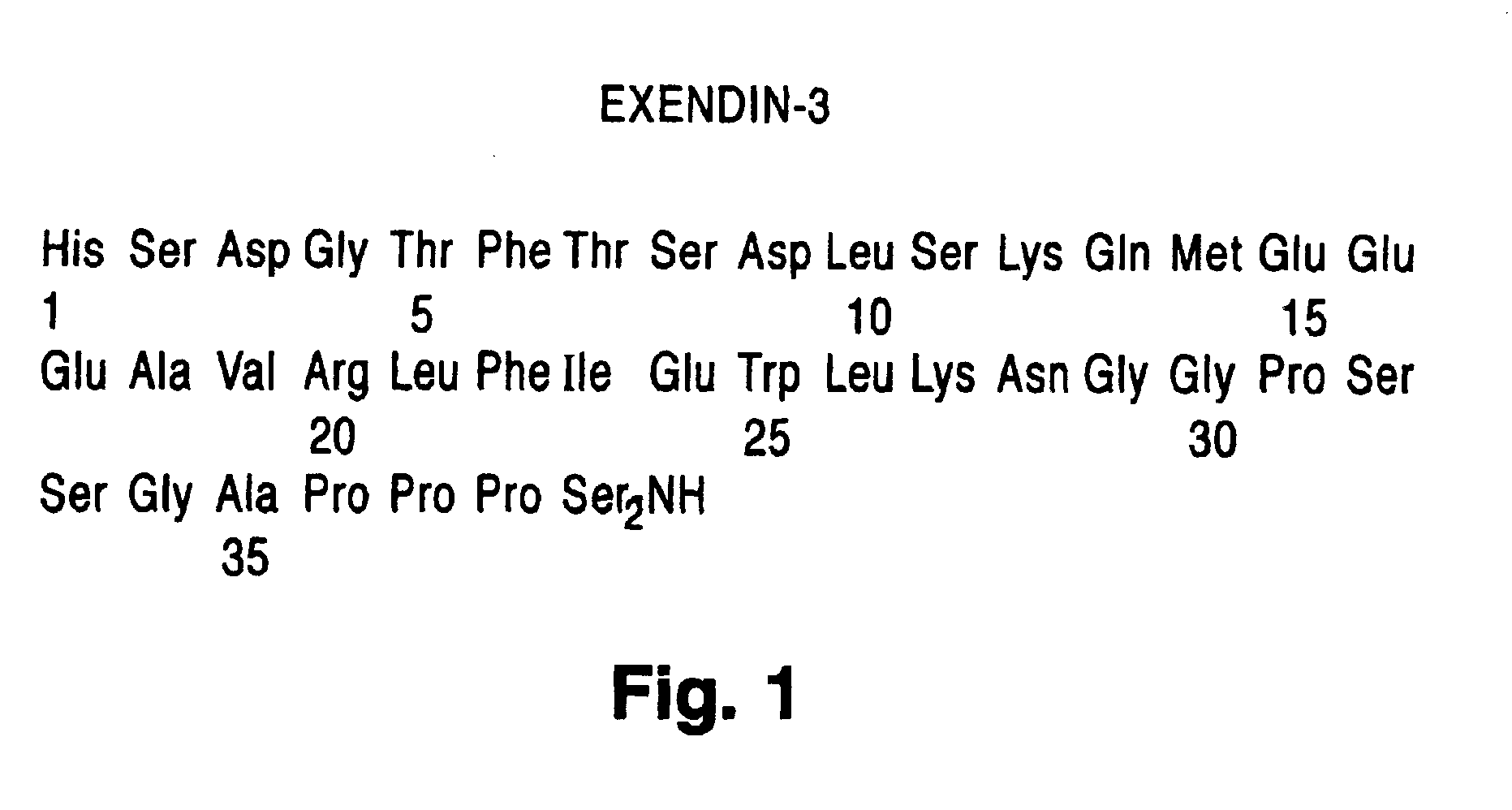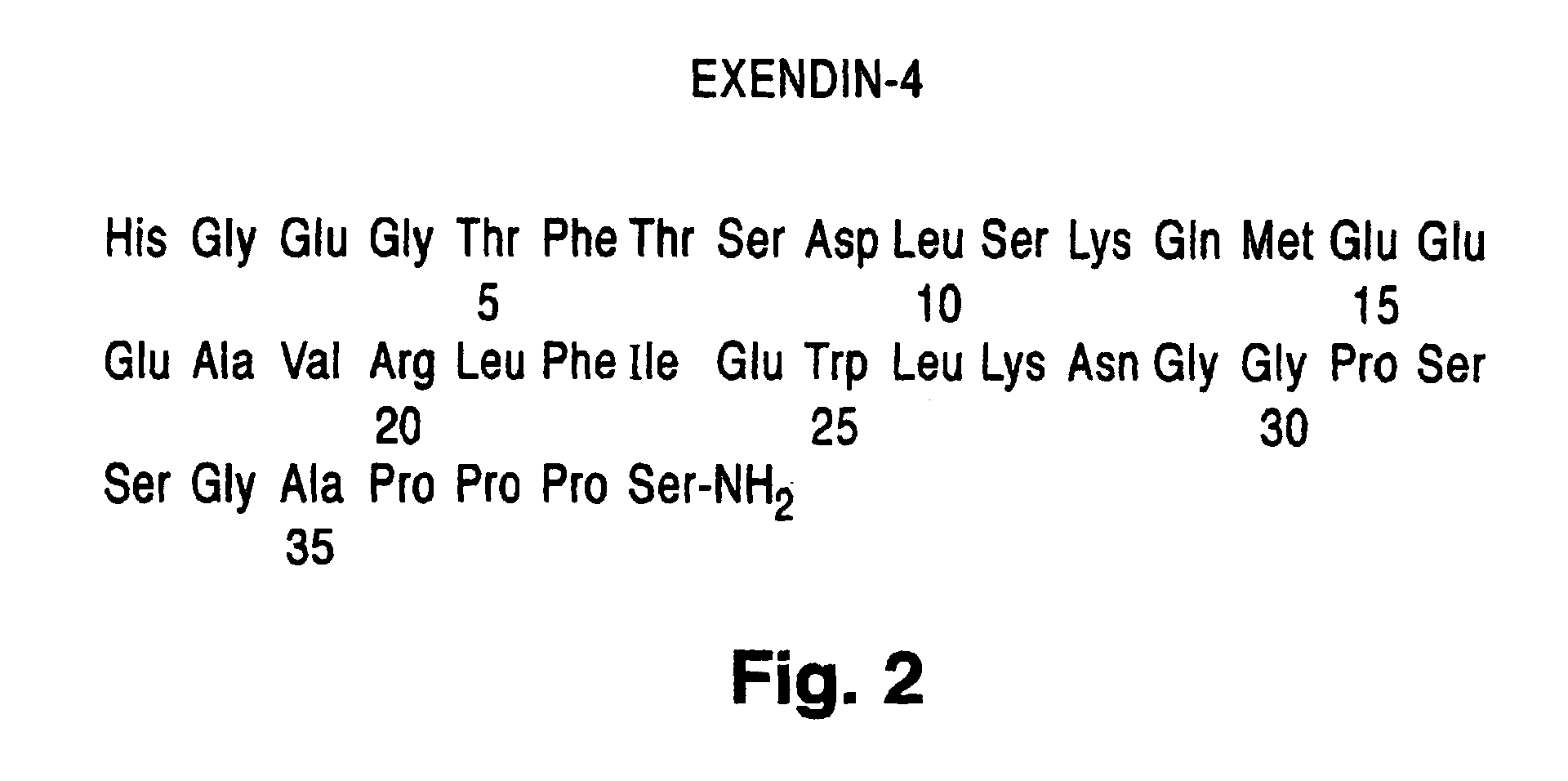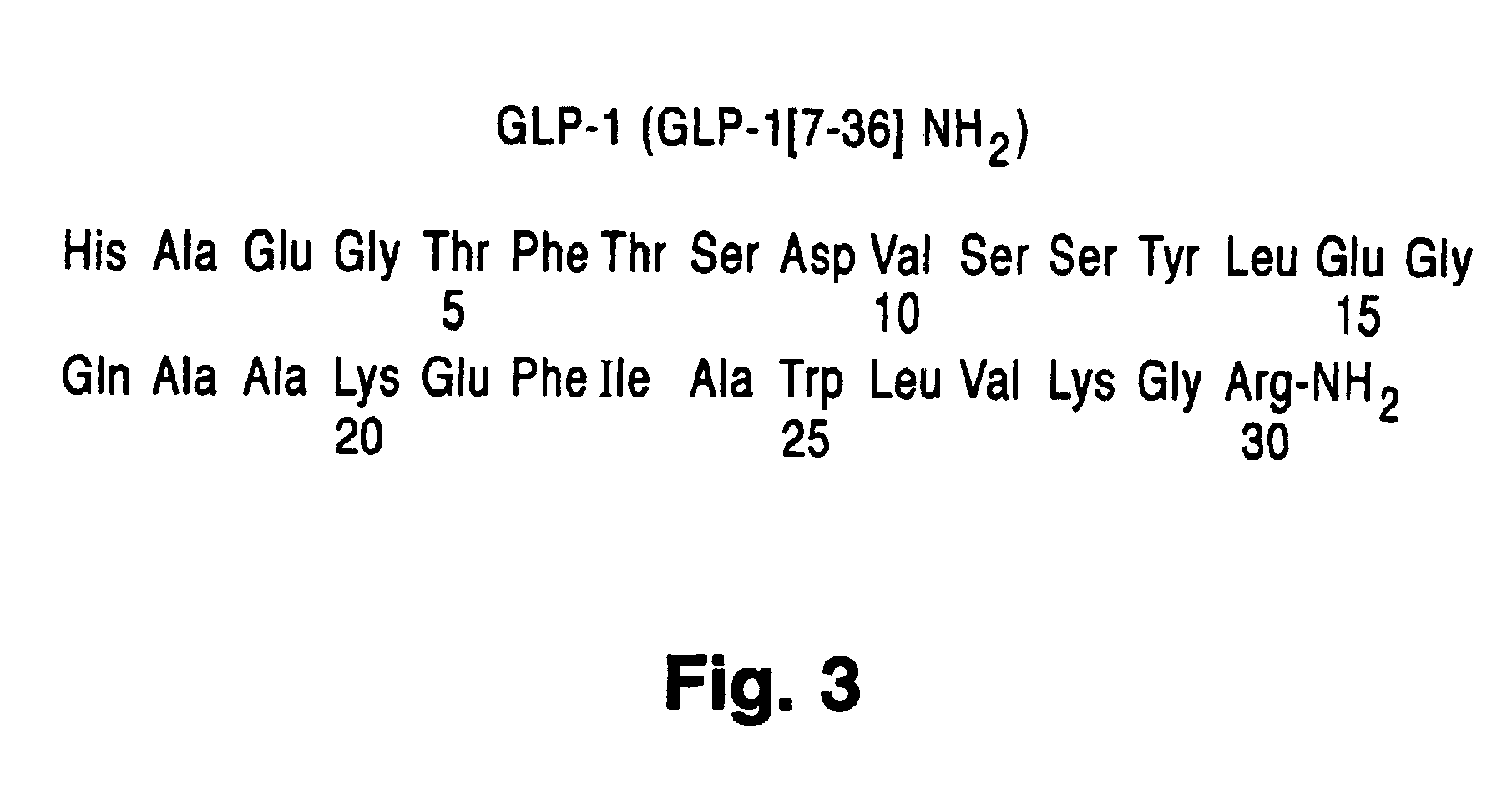Exendin agonist formulations and methods of administration thereof
a technology of exendin and agonist, applied in the field of new drugs, can solve the problems of thwarted, but often not practical, administration of peptide drugs by other routes than subcutaneous or intravenous injection, intravenous infusion, etc., and achieve the effects of reducing food intake, lowering plasma glucose levels, and slow gastric emptying
- Summary
- Abstract
- Description
- Claims
- Application Information
AI Technical Summary
Benefits of technology
Problems solved by technology
Method used
Image
Examples
example 1
Preparation of Exendin-3
His Ser Asp Gly Thr Phe Thr Ser Asp Leu Ser Lys Gln Met Glu Glu Glu Ala Val Arg Leu Phe Ile Glu Trp Leu Lys Asn Gly Gly Pro Ser Ser Gly Ala Pro Pro Pro Ser-NH2 [SEQ. ID. NO. 1]
[0241]The above amidated peptide was assembled on 4-(2′-4′-dimethoxyphenyl)-Fmoc aminomethyl phenoxy acetamide norleucine MBHA resin (Novabiochem, 0.55 mmole / g) using Fmoc-protected amino acids (Applied Biosystems, Inc.). In general, single-coupling cycles were used throughout the synthesis and Fast Moc (HBTU activation) chemistry was employed. Deprotection (Fmoc group removal) of the growing peptide chain was achieved using piperidine. Final deprotection of the completed peptide resin was achieved using a mixture of triethylsilane (0.2 mL), ethanedithiol (0.2 mL), anisole (0.2 mL), water (0.2 mL) and trifluoroacetic acid (15 mL) according to standard methods (Introduction to Cleavage Techniques, Applied Biosystems, Inc.) The peptide was precipitated in ether / water (50 mL) and centrifug...
example 2
Preparation of Exendin-4
His Gly Glu Gly Thr Phe Thr Ser Asp Leu Ser Lys Gln Met Glu Glu Glu Ala Val Arg Leu Phe Ile Glu Trp Leu Lys Asn Gly Gly Pro Ser Ser Gly Ala Pro Pro Pro Ser-NH2 [SEQ. ID. NO. 2]
[0244]The above amidated peptide was assembled on 4-(2′-4′-dimethoxyphenyl)-Fmoc aminomethyl phenoxy acetamide norleucine MBHA resin (Novabiochem, 0.55 mmole / g) using Fmoc-protected amino acids (Applied Biosystems, Inc.), cleaved from the resin, deprotected and purified in a similar way to Exe din-3 as describe in Example 1. Used in analysis were Solvent A (0.1% TFA in water) and Solvent B (0.1% TFA in ACN). Analytical RP-HPLC (gradient 36% to 46% Solvent B in Solvent A over 30 minutes) of the lyophilized peptide gave product peptide having an observed retention time of 14.9 minutes. Electrospray Mass Spectrometry (M): calculated 4186.6; found 8186.0 to 4186.8 (four lots).
example 3
Exendin-4 is a Circulating, Meal-Related Peptide in the Gila Monster
[0245]This experiment investigated whether exendin-4 has a metabolic role in the Gila monster lizard itself. To investigate whether exendin-4 appeared in the blood of the Gila monster in response to feeding, blood was sampled from one animal fasted for 7 weeks, before and 30 min after ingestion of a small rat. Plasma was assayed for full-length exendin-4 using an immunoradiometric assay with monoclonal antibody pairs directed to epitopes at N- and C-termini of exendin-4. Fasting plasma exendin-4 concentration was 76 pg / mL, near the lower limit of quantitation. After eating, this value rose 300-fold to 23,120 pg / mL.
[0246]In a second experiment, serial samples were taken from two animals fasted five weeks before and after ingestion of one or two small rats (47-49 g). Plasma exendin-4 concentration rose 23- to 36-fold (to 4860, 8340 pg / mL) immediately after eating, consistent with a direct passage of exendin-4 from the...
PUM
| Property | Measurement | Unit |
|---|---|---|
| Fraction | aaaaa | aaaaa |
| Fraction | aaaaa | aaaaa |
| Fraction | aaaaa | aaaaa |
Abstract
Description
Claims
Application Information
 Login to View More
Login to View More - R&D
- Intellectual Property
- Life Sciences
- Materials
- Tech Scout
- Unparalleled Data Quality
- Higher Quality Content
- 60% Fewer Hallucinations
Browse by: Latest US Patents, China's latest patents, Technical Efficacy Thesaurus, Application Domain, Technology Topic, Popular Technical Reports.
© 2025 PatSnap. All rights reserved.Legal|Privacy policy|Modern Slavery Act Transparency Statement|Sitemap|About US| Contact US: help@patsnap.com



